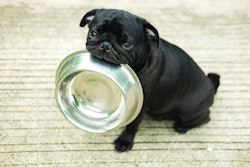
(petrmalinak | Shutterstock.com)
Ever since the melamine-related pet food recalls in 2007, as manufacturers, industry suppliers, consumers, retailers and regulators have focused even more intently on pet food safety, one sentiment I’ve often heard expressed is, “Everyone in the industry must work together on this. Pet food safety cannot be treated as a competitive advantage.”
While that concept hasn’t always held true, I think by and large, the industry has indeed collaborated—not only among competitive companies but also with regulatory bodies like the Food and Drug Administration (FDA) and associations such as the Pet Food Institute (PFI) and American Feed Industry Association (AFIA)—to ensure that heightened safety standards, protocols and processes were developed, implemented and followed.
As an industry, we seem to have reached another point where collaboration, rather than competition, is necessary to achieve progress: pet food sustainability.
Perhaps an example that epitomizes the complexity and need for standardization and agreement lies with the life cycle analysis (LCA), an increasingly common tool for measuring aspects of sustainability. According to ISO 14044:2006, a global certification standard for environmental management, LCA is a “globally recognized model framework to study the environmental impact categories associated with a product or process.”
That definition, and much more information about LCA, was provided by Heather Acuff, a third-year Ph.D. student at Kansas State University and product development manager for Nulo Pet Food, during a webinar, “How sustainability is impacting pet food ingredients, packaging.” Yet the LCA model might help pet food more if the industry strived for agreement on how to implement its various stages, such as the first one defining the goal and scope.
“If somebody’s asking, ‘what’s the most sustainable ingredient in pet food,’ it highly, highly depends,” Acuff said. “It depends on the ingredients themselves, how they were raised, and how the LCA was performed. So we may not be able to do direct comparisons unless there’s a standardized way for LCA to be a fair comparison across different industries and food types.”
She continued that, at this point, pet food is still very much in the quantification stage, but as more data is generated (and that’s accelerating all the time), industry members can use tools like LCA to improve different segments of the industry, including raw materials. Yet even the data can be a sticking point.
“I think one of the biggest challenges is getting data out there,” Acuff said during the Q&A part of the webinar. “As far as industry research, it’s very difficult to get your hands on metrics that are available not just for raw materials but also for packaging suppliers. So as a manufacturer that’s making several different types of products, it would be great to have a library of data to say, how do I build my most sustainable product using the sustainable packaging materials and ingredients and distribution networks, and having all that in one place early in the development cycle.”
As a sustainability example, the Pet Sustainability Coalition’s (PSC) members include more than 40 pet food and treat manufacturers, more than 25 pet food supplier companies, several pet retailers and three independent pet distributors—all companies that, within their respective sectors, typically compete directly with the others.
A press release from PSC about the three pet distributors becoming members even declared, “Collaboration is the new competition.” That may be a bit of a reach (even a brainteaser), but it does get at the concept quickly.
PSC is just one of the seven organizations that TC Transcontinental Packaging works with. “Collaboration is key,” Casey said. “Each one of the stakeholders, even from the beginning of the value chain to the end of the value chain, really will have an impact on the sustainable packaging journey and creating that flexible package. For example, biodegradable packaging would be BPI [Biodegradable Products Institute], which helps with labeling.”
For any part of the pet food value chain, and for the industry overall, achieving sustainability depends on cooperation. “The successful implementation of these strategies requires collaboration among different industry stakeholders as well as regulators and pet owners, as the value of these products may be a little different than some of the products on the market today,” Acuff said. “So it will definitely take a combined effort for this to work successfully.”
LinkedIn
Facebook
Twitter
While that concept hasn’t always held true, I think by and large, the industry has indeed collaborated—not only among competitive companies but also with regulatory bodies like the Food and Drug Administration (FDA) and associations such as the Pet Food Institute (PFI) and American Feed Industry Association (AFIA)—to ensure that heightened safety standards, protocols and processes were developed, implemented and followed.
As an industry, we seem to have reached another point where collaboration, rather than competition, is necessary to achieve progress: pet food sustainability.
Agreeing on pet food sustainability standards, metrics
For starters, sustainability is not readily defined and can often mean many things to many people, especially when it comes to consumer perceptions. Sustainability is also a complex, multifaceted area, so just agreeing on definitions and metrics requires collaboration.Perhaps an example that epitomizes the complexity and need for standardization and agreement lies with the life cycle analysis (LCA), an increasingly common tool for measuring aspects of sustainability. According to ISO 14044:2006, a global certification standard for environmental management, LCA is a “globally recognized model framework to study the environmental impact categories associated with a product or process.”
That definition, and much more information about LCA, was provided by Heather Acuff, a third-year Ph.D. student at Kansas State University and product development manager for Nulo Pet Food, during a webinar, “How sustainability is impacting pet food ingredients, packaging.” Yet the LCA model might help pet food more if the industry strived for agreement on how to implement its various stages, such as the first one defining the goal and scope.
“If somebody’s asking, ‘what’s the most sustainable ingredient in pet food,’ it highly, highly depends,” Acuff said. “It depends on the ingredients themselves, how they were raised, and how the LCA was performed. So we may not be able to do direct comparisons unless there’s a standardized way for LCA to be a fair comparison across different industries and food types.”
She continued that, at this point, pet food is still very much in the quantification stage, but as more data is generated (and that’s accelerating all the time), industry members can use tools like LCA to improve different segments of the industry, including raw materials. Yet even the data can be a sticking point.
“I think one of the biggest challenges is getting data out there,” Acuff said during the Q&A part of the webinar. “As far as industry research, it’s very difficult to get your hands on metrics that are available not just for raw materials but also for packaging suppliers. So as a manufacturer that’s making several different types of products, it would be great to have a library of data to say, how do I build my most sustainable product using the sustainable packaging materials and ingredients and distribution networks, and having all that in one place early in the development cycle.”
‘Collaboration is the new competition’
Acuff believes collaboration is essential in establishing such a library of data and standardizing application of tools like LCA. Her co-speaker during the webinar, Rebecca Casey, senior vice president of marketing and strategy for TC Transcontinental Packaging, also stressed the necessity for collaboration and explained how her company partners with several non-profit organizations and associations on its quest to create and encourage sustainable pet food packaging. These entities are quintessential examples of collaboration that are able to attract competitors and encourage them to work together, just as PFI, AFIA and others did with FDA to create new pet food safety protocols.As a sustainability example, the Pet Sustainability Coalition’s (PSC) members include more than 40 pet food and treat manufacturers, more than 25 pet food supplier companies, several pet retailers and three independent pet distributors—all companies that, within their respective sectors, typically compete directly with the others.
A press release from PSC about the three pet distributors becoming members even declared, “Collaboration is the new competition.” That may be a bit of a reach (even a brainteaser), but it does get at the concept quickly.
PSC is just one of the seven organizations that TC Transcontinental Packaging works with. “Collaboration is key,” Casey said. “Each one of the stakeholders, even from the beginning of the value chain to the end of the value chain, really will have an impact on the sustainable packaging journey and creating that flexible package. For example, biodegradable packaging would be BPI [Biodegradable Products Institute], which helps with labeling.”
For any part of the pet food value chain, and for the industry overall, achieving sustainability depends on cooperation. “The successful implementation of these strategies requires collaboration among different industry stakeholders as well as regulators and pet owners, as the value of these products may be a little different than some of the products on the market today,” Acuff said. “So it will definitely take a combined effort for this to work successfully.”

















